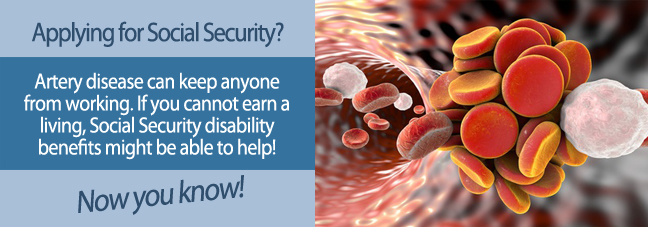The term “artery disease” describes a number of disorders involving blockage, constriction, or deterioration of the body’s arteries. Depending on the type and severity, patients can experience anything from minor symptoms to life-altering diagnoses that require constant care.
If your artery disease prevents you from working or living your normal life, the Social Security disability benefits may be an answer. Before applying for financial benefits through this program, continue below to learn the best 3 tips for applicants with artery disorders.
Tip #1: Speak With Your Physician First
The human body contains millions of arteries all throughout the body. However, certain groups or types of arteries are more prone to artery disease than others. Depending on the location and severity of your artery disease, there may be different requirements of you to receive disability benefits.
Before applying, speak with your physician to learn the specifics of your disorder and document all of the ways your artery disease limits you.
For example, those with peripheral artery disease (PAD) may experience mobility issues, chronic pain, swelling in the limbs, or even gangrene if left untreated. In contrast, those with coronary artery disease (CAD) may experience shortness of breath, heart palpitations, angina, strokes, or even require surgery.
Tip #2: Get Renewed angiography Tests, ABI tests, CT scans, or Ultrasounds.
For the Social Security Administration (SSA) to approve an applicant, they must be completely up-to-date on every aspect of the applicant’s medical condition. Even out-of-date tests can be the difference between an application being improved or denied, so it is important to redo tests if they may yield different results. For instance, angiography tests and ultrasounds can be used (and compared to previous results) to scan affected areas and measure blood flow through affected arteries. ABI tests are especially useful for those with PAD to measure especially constricted blood flow in the leg area. Depending on your diagnosis, your physician may recommend different tests to better assess your current condition.

Tip #3: Regularly Update the SSA after applying for benefits.
Most people assume that the application process is out of their hands once their paperwork is officially submitted. However, a majority of applications take a period of months before applicants receive a verdict. During this time, it is important to consistently update the SSA on any changes in your condition.
Even if you only receive duplicates of previous tests, these results can be compared to tests that were submitted previously and more properly represent your case. The SSA encourages updates such as these because they a) show proactivity, and b) provide additional evidence to observe, increasing your chances at receiving benefits.
Contacting an Attorney
For your best chance at receiving the benefits your deserve, consider contacting a disability attorney. Their expertise in the field of disability benefits can give you an edge on your application, help you keep paperwork organized, and ensure the process is simple and mistake-free.
Even better, disability attorneys are federally regulated, which means they are unable to receive any payment from you unless their efforts win you your case.
Contact a disability attorney near your today for a free consultation before beginning your Social Security application.